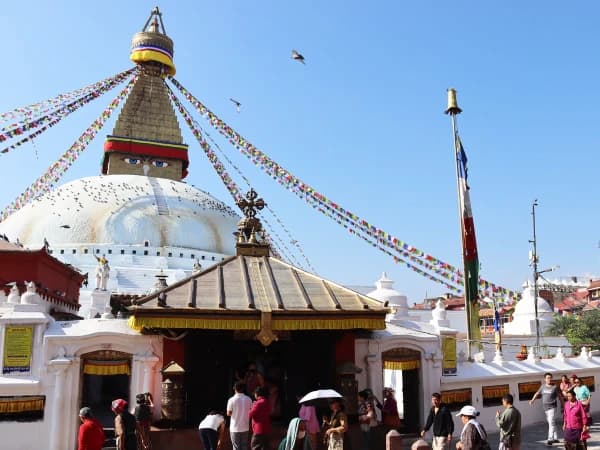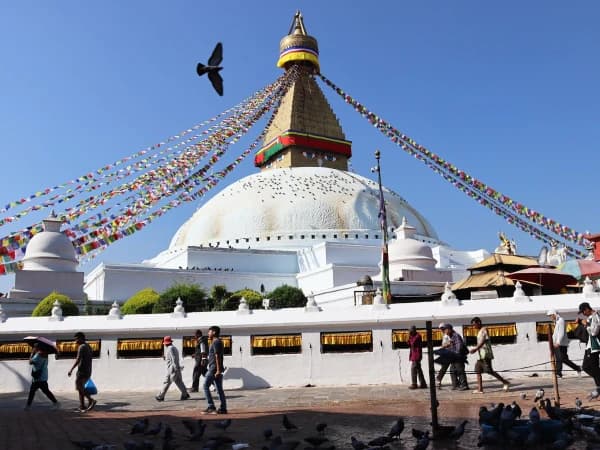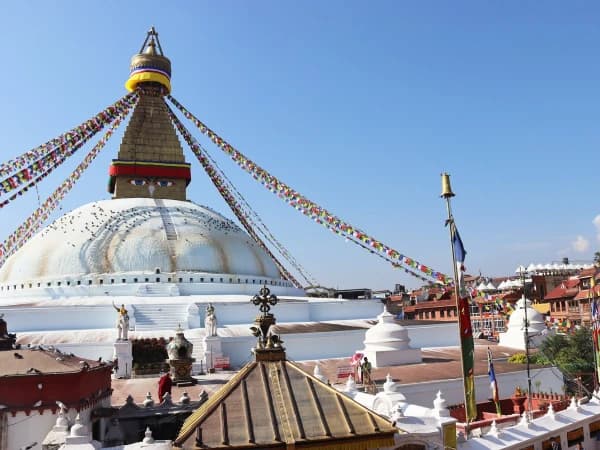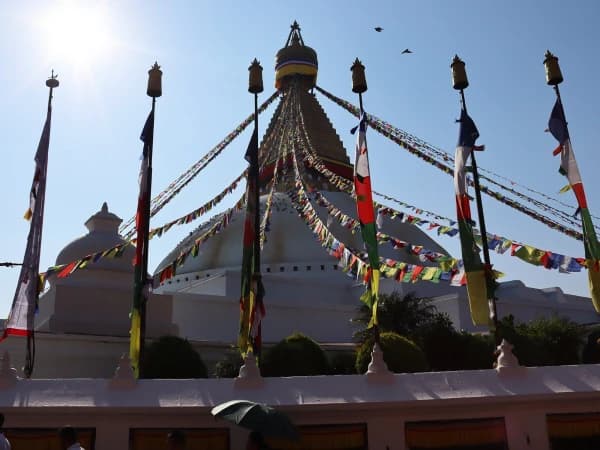Boudhanath is a significant Buddhist monument listed as a UNESCO World Heritage Site in Kathmandu, Nepal. Buddhism teaches that there is a hidden Buddha within every human being, and through meditation and practice, one can awaken this inner essence. The philosophy of the Buddhist lifestyle emphasizes achieving a peaceful mind by embracing the principle of impermanence — the understanding that nothing in life is permanent. Everything that is born must eventually pass away. Buddhism encourages the eradication of negative thoughts by cultivating loving-kindness and compassion. A visit to Boudhanath offers profound insights into the impermanence of life, inspiring visitors to find joy and contentment in every moment. If you are seeking peace, prosperity, and happiness, Boudhanath is a destination you must experience.
Introduction
Boudhanath, the world's largest stupa, is an architectural and spiritual marvel located in the northeastern part of Kathmandu, Nepal. Rooted in Buddhist philosophy, it holds profound symbolic and cultural significance. According to Buddhist teachings, there are 108 kleshas or defilements—negative mental states such as ignorance, attachment, and aversion—that hinder an individual's journey toward liberation. The number 108 carries spiritual importance, reflected in practices like reciting prayers or mantras 108 times to counteract these defilements. Interestingly, the stupa’s height of 108 feet aligns with this sacred number, underscoring its spiritual symbolism.
The stupa's massive white dome is crowned by a gilded spire featuring the all-seeing eyes of Buddha, a representation of wisdom and compassion. Designed as a mandala, the stupa embodies the universe and Buddhist cosmology. The structure serves as a place for meditation, pilgrimage, and religious ceremonies. In cosmological terms, the number 108 also symbolizes the approximate distance between the Earth, the Moon, and the Sun, which is about 108 times their respective diameters.
Believed to have been constructed during the 5th or 6th century, Boudhanath Stupa is one of the most significant Buddhist stupas in the world and a major pilgrimage site for Tibetan Buddhists. Its central dome is surrounded by 108 smaller stupas and prayer wheels, further reinforcing the spiritual significance of this number. The large, all-seeing eyes painted on each side of the structure symbolize the Buddha's omniscient awareness, watching over all beings with compassion and wisdom.
Beyond its religious importance, Boudhanath Stupa serves as a vibrant cultural hub for Tibetan Buddhists in Nepal. The area is home to numerous monasteries, shops, and restaurants, creating a lively center for spiritual practice and cultural exchange. Recognized for its exceptional historical and cultural value, Boudhanath was designated a UNESCO World Heritage Site in 1979.
History
Have you ever noticed a dewdrop shimmering in the rays of the sun? The Boudhanath Stupa is often compared to this fleeting beauty, symbolizing impermanence and spiritual clarity. According to legend, during the reign of Lichhavi King Dharmadeva (450–464), an old poultry woman, known as Ajima, sought permission to build the stupa. Initially hesitant, the king accidentally granted her permission in a moment of oversight. This unintentional approval earned the site the name Jhyarung Khasur (accidental wish fulfilled). Cleverly, Ajima used the skin of a buffalo to demarcate the land by cutting it into strips to cover as much area as possible.
During this time, King Dharmadeva favored Northern Tibetan Buddhism, while his son, King Mandeva, leaned toward Southern Indian Hinduism, leading to cultural and ideological clashes. In one tragic tale, King Dharmadeva attempted to end a severe drought by building a tap (water spout). Astrologers predicted that water would flow only if a person with 32 qualities of perfection was sacrificed. Both the king and his son met these criteria. The king instructed his son to slay whoever appeared at the tap at dawn. To save his son, Dharmadeva disguised himself and was killed. His severed head flew to Bajrayogini, while a rooster he had placed at the site flew toward Boudhanath and Sankhu, connecting the sites in spiritual significance.
Despite the drought and the king’s death, Ajima and her four sons persevered. They collected dewdrops in white cloths and began building a small stupa, known as Khasti Mahachaitya in the Newari language, meaning "dew drop stupa." They brought the ashes (astu) of Kasyapa Buddha from Banaras to enshrine within it. Legend holds that Ajima and her four sons attained nirvana and became the Four Heavenly Kings, representing the Buddhist virtues of loving-kindness (metta), compassion (karuna), empathetic joy (mudita), and equanimity (upekkha).
From a Tibetan perspective, the four brothers were reincarnated in roles vital to Tibetan Buddhism. The eldest became Dharma King Songtsen Gampo of Tibet, who married Princess Vrikuti (Green Tara), the daughter of King Amsuvarma (605–621). She brought sacred Shakyamuni Buddha statues to Tibet, now housed at Jokhang and Ramoche temples. The second brother, Padma Gungtsen, became a minister; the third, Shantarakshita, an abbot; and the fourth, Padmasambhava Guru Rinpoche (Chenrezig), a revered spiritual leader.
Later, King Śivadeva I (590–604) began restoring the stupa. After King Amsuvarma's death in 621, Songtsen Gampo visited Nepal and further reconstructed the stupa, placing Amsuvarma’s astu within. The current structure was built by Songtsen Gampo in the 7th century. Following the Chinese invasion of Tibet in 1959, many Tibetan refugees settled around Boudhanath, transforming it into a vibrant center of Tibetan culture and earning it the nickname "Mini Tibet." In 1979, Boudhanath Stupa was designated a UNESCO World Heritage Site. The monument sustained significant damage during the 2015 Nepal earthquake, causing the central spire to collapse. Through the combined efforts of local communities and international supporters, the stupa was restored, with renovations completed in 2016.
Philosophy
The philosophy of Boudhanath is deeply rooted in Buddhist teachings, particularly the Vajrayana tradition, which emphasizes the path to enlightenment through wisdom, compassion, and devotion. The stupa’s intricate design is a symbolic representation of the Buddha’s enlightened mind and the structure of the universe in Buddhist cosmology.
The central dome signifies the world, while the all-seeing eyes of Buddha, painted on the stupa, represent the Buddha’s omniscient awareness, eternally observing and guiding beings toward enlightenment. Surrounding the main stupa are 108 smaller stupas, a sacred number in Buddhism, symbolizing the purification of 108 defilements and the spiritual progression toward liberation. Prayer wheels encircling the stupa are inscribed with mantras, and their rotation is believed to release prayers into the universe, generating merit and purifying the mind and soul. Devotees practice circumambulation (kora) around the stupa while chanting mantras, which fosters mindfulness and cultivates compassion.
Boudhanath serves as both a physical and spiritual center, offering a space for meditation, devotion, and self-transformation. It embodies the core Buddhist ideals of compassion, mindfulness, and the realization of Buddha-nature, guiding practitioners toward liberation from the cycle of suffering (samsara).
Attractions
Buddha’s Eyes
The eyes of Buddha on the Boudhanath Stupa carry profound symbolic meaning in Buddhism. The large, all-seeing eyes painted on all four sides of the stupa represent the Buddha's omnipresent awareness, symbolizing his boundless compassion and wisdom, through which he observes and guides all beings. The vertical third eye, positioned between the two eyes, signifies spiritual insight and the awakened mind. It points toward the ability to perceive beyond the physical realm, accessing deeper truths about existence. The infinite gaze of the eyes embodies the Buddha’s unwavering compassion for all sentient beings, constantly watching over them and leading them toward enlightenment. These eyes serve as a reminder to practitioners that, although we are bound by the cycle of life and death (samsara), the Buddha's wisdom is ever-present, offering a path toward liberation and inner peace.
Circumambulation
The practice of Kora, or circumambulation, around the Boudhanath Stupa is a deeply symbolic and spiritual act in Buddhism. Devotees walk around the stupa in a clockwise direction, often reciting mantras or spinning prayer wheels as they do so. This act is not merely a physical movement but a profound expression of devotion, purification, and spiritual progress.
The act of circling the stupa represents the cycle of samsara—the cycle of birth, death, and rebirth—and the movement symbolizes the practitioner's commitment to breaking free from this cycle and attaining enlightenment. Each step taken during the Kora is believed to generate merit, purify negative karma, and bring the practitioner closer to liberation. The clockwise direction aligns the practitioner with the universe’s natural rhythm, drawing positive energy and reinforcing the flow of cosmic forces.
Ultimately, the practice of Kora embodies the philosophy of mindful presence, compassion, and the continuous journey toward awakening and inner peace.Devotees sometimes perform 108 prostrations as an expression of devotion, humility, and dedication. Laying Kora, or prostrating during circumambulation, is an intensified and deeply devotional practice, particularly observed around sacred sites like the Boudhanath Stupa. In this ritual, devotees perform a full-body prostration by lying flat on the ground before rising and continuing their movement around the stupa. This act symbolizes a deep surrender to the Buddha's teachings. Each prostration is not only a physical gesture but also a symbolic one, representing the devotee’s renunciation of ego and attachment, which are key steps on the path to enlightenment.
Participation in Ritual Karma
In some Buddhist traditions, bells are rung 108 times to mark the arrival of the New Year, symbolizing purification and renewal. Anyone can participate in the following rituals at Boudhanath:
- Circumambulation (Kora or Parikrama): Walking around the stupa in a clockwise direction while focusing on the Buddha's teachings and intentions. This practice is often accompanied by the spinning of prayer wheels and chanting mantras such as "Om Mani Padme Hum."
- Lighting Butter Lamps: Offering butter lamps or candles at the stupa symbolizes dispelling ignorance and bringing light (wisdom). This ritual is significant for accumulating merit and purifying negative karma.
- Offering Flowers and Incense: Devotees offer flowers to the stupa and surrounding statues as a sign of respect and devotion. Burning incense purifies the environment and creates a sacred atmosphere.
- Prayer Wheel Spinning: Spinning prayer wheels inscribed with mantras, particularly "Om Mani Padme Hum," is believed to multiply the effects of prayer. Each turn of the wheel is considered the chanting of the mantra, contributing to the accumulation of merit.
- Chanting and Reciting Mantras: Devotees chant various mantras like "Om Mani Padme Hum," "Om Ah Hum," and "Namo Buddha" to purify the mind and accumulate good karma. This can be done individually or in groups around the stupa or in nearby monasteries.
- Torma Offering (Ritual Cakes): Torma offerings are symbolic cakes made from barley flour and butter, used in Tibetan Buddhist rituals, especially in monasteries around the stupa. These offerings are made to deities, spirits, or the Buddha to invite blessings and remove obstacles.
- Prostrations: Devotees bow down to the stupa or Buddha statues as an expression of humility, reverence, and devotion. Prostrations are believed to purify past karma and develop a humble heart.
- Meditation and Reflection: Engaging in meditation around the stupa or in nearby monasteries is a common practice to gain deeper spiritual insight. Meditative practices often focus on themes such as impermanence, compassion, and mindfulness.
- Offering Food and Donations: Devotees offer food, particularly to the monks and nuns in surrounding monasteries, as a gesture of support for the spiritual community and to accumulate merit. Some also make charitable donations for the maintenance of the stupa and Buddhist education.
- Participating in Tibetan Buddhist Festivals: Key festivals like Losar (Tibetan New Year), Saka Dawa, and Buddha Jayanti feature elaborate rituals, including group prayers, dances, offerings, and recitations. Monks and lamas perform special prayers and pujas (ritual ceremonies) to celebrate these occasions.
- Fasting and Vows: Some devotees practice fasting or make vows to purify their karma and gain spiritual merit, particularly during significant Buddhist holidays and festivals.
- Mandala Offerings: Creating sand mandalas or visualizing them during prayer is a common practice among Tibetan Buddhists. Offering mandalas symbolizes the entire universe being offered to the Buddha and the attainment of enlightenment.
- Reciting Sutras: Sutras (Buddhist scriptures) are recited during various rituals to promote spiritual wisdom and guide individuals on the path to enlightenment. Monks and practitioners gather in the courtyards of Boudhanath to recite these texts.
- These rituals are deeply rooted in Tibetan Buddhism and practiced by both locals and visitors. They are believed to purify negative karma, invite positive energy, and strengthen the connection between practitioners and the Buddha’s teachings.
Tibetan Monasteries and Culture
The Tibetan monasteries around Boudhanath Stupa form a vibrant spiritual and cultural hub, significantly shaping the area’s religious and social life. Following the influx of Tibetan refugees after the Chinese occupation of Tibet, Boudhanath has become a central place for Tibetan Buddhism. Monasteries such as Ganden Sikyong Monastery, Shechen Monastery, and Kopan Monastery surround the stupa, providing spaces for meditation, teachings, and communal worship. These monasteries preserve traditional Tibetan Buddhist practices, including ritual ceremonies, lamrim teachings, and the recitation of mantras and sutras.
Tibetan culture is evident in the area’s architecture, with prayer wheels, colorful prayer flags, and thangka paintings adorning the monasteries. The influence of Tibetan culture also comes alive during festivals like Losar (Tibetan New Year), when the area is filled with communal prayers, dances, and rituals. Boudhanath serves as a sanctuary where Tibetan Buddhism and culture continue to flourish, creating a harmonious blend of spirituality, art, and tradition.
Peace of Mind - Meditation
Meditation at Boudhanath offers a unique opportunity to attain peace of mind, as the tranquil surroundings of the Boudhanath Stupa and the nearby Tibetan monasteries provide an ideal environment for deep reflection and mindfulness. Pilgrims and practitioners gather here to meditate, often while circumambulating the stupa or sitting in quiet corners of the monasteries. The sacred atmosphere, accompanied by the rhythmic chanting of mantras, the spinning of prayer wheels, and the gentle sounds of temple bells, creates a serene space that helps calm the mind.
Various meditation practices, including Vipassana (insight meditation) and Shamatha (concentration meditation), are widely practiced by locals, Tibetan refugees, and visitors seeking both spiritual insight and inner peace. Offering prayers, lighting butter lamps, and engaging in rituals further enhance the meditative experience, allowing individuals to cultivate mindfulness, release stress, and connect with a profound sense of peace and harmony.
Bodhichitta
In Boudhanath, the concept of Bodhicitta—the compassionate aspiration to attain enlightenment for the benefit of all sentient beings—is deeply woven into the spiritual practices of the community. Devotees and practitioners who visit this sacred site often engage in meditation and prayers with the intention of cultivating Bodhicitta. By circumambulating the Boudhanath Stupa, offering prayers, lighting butter lamps, and chanting mantras like Om Mani Padme Hum, practitioners foster an altruistic mindset, focusing on the well-being and liberation of others.
The serene atmosphere, combined with surrounding Tibetan Buddhist teachings, nurtures a powerful sense of compassion and interconnectedness. Through these acts, individuals express their commitment to Bodhicitta, aspiring to transform their hearts and minds in order to benefit others, thereby accumulating merit on the path to enlightenment. Boudhanath, with its vibrant Tibetan Buddhist community and rich cultural and spiritual heritage, serves as a constant reminder of the profound importance of cultivating selfless love and compassion in daily life. Buddhist prayer beads (mala), commonly used for prayer and meditation, usually contain 108 beads. Practitioners recite a mantra 108 times, symbolizing a journey toward spiritual enlightenment and complete focus.
Chanting
The number 108 holds sacred significance in Buddhism, as well as in other Eastern spiritual traditions such as Hinduism and Jainism. It symbolizes the universe and the completeness of existence. At Boudhanath, the rows of prayer wheels inscribed with mantras like Om Mani Padme Hum further embody this sacred concept. Chanting at Boudhanath Stupa is a central aspect of spiritual practice for Buddhists and visitors seeking peace and blessings. The most commonly recited mantra is Om Mani Padme Hum, which encapsulates the essence of compassion and wisdom in Tibetan Buddhism. This six-syllable mantra is believed to invoke the blessings of Avalokiteshvara, the Bodhisattva of Compassion.
As devotees chant, they often spin prayer wheels inscribed with mantras, amplifying the prayers with every turn. Chanting at Boudhanath is not only a meditative practice but also an offering of devotion, purifying the mind, generating merit, and aligning with the stupa's spiritual energy. The rhythmic recitation fosters a sense of inner peace and connects practitioners to the universal flow of positive energy. In this sacred space, the collective chanting by individuals from diverse backgrounds creates an atmosphere of unity, reverence, and spiritual transformation.
Rooftop Cafes
The rooftop cafes surrounding Boudhanath Stupa offer a unique blend of tranquility, culture, and breathtaking views. These cafes provide visitors with an opportunity to relax while enjoying the majestic sight of the stupa and witnessing the vibrant activity of devotees performing Kora below. Renowned for their serene ambiance, the cafes serve a variety of Nepalese, Tibetan, and international cuisine, including butter tea, momos, and vegetarian dishes that align with Buddhist traditions.
Many of these cafes incorporate subtle spiritual elements into their decor, enhancing the meditative atmosphere of the area. Visitors can savor meals or beverages while observing the stupa’s symbolic architecture and listening to the rhythmic chants of pilgrims, creating a deeply immersive experience. These cafes are not just places to dine, but also hubs for cultural exchange, offering a unique way to connect with the spiritual and communal energy of Boudhanath.
Useful Information to visitors
- Respect Local Customs: Always walk clockwise around the stupa (performing Kora), as this follows Buddhist traditions. Avoid pointing your feet toward the stupa when sitting or taking photos.
- Dress Modestly: Wear attire that covers your shoulders and knees, as Boudhanath is a place of spiritual significance.
- Photography: Photography is allowed, but be mindful of monks, devotees, and ceremonies. Always ask for permission before photographing people, especially during religious activities.
- Quiet Reflection: Maintain respectful silence or speak in hushed tones, as many visitors are engaged in meditation or chanting.
- Engage with Local Culture: Explore the surrounding monasteries and shops for authentic handicrafts, prayer flags, and Buddhist artifacts.
- Taste Local Cuisine: Try Tibetan butter tea, momos, or other traditional dishes at nearby rooftop cafes while enjoying a panoramic view of the stupa.
- Participate Mindfully: Feel free to spin prayer wheels or light butter lamps, but do so with respect and devotion.
- Best Time to Visit: Early mornings or evenings are the ideal times to experience the stupa’s spiritual energy and the serene atmosphere of chanting and prayer.
- Contribute Thoughtfully: Consider making a donation to the monasteries or purchasing items from local artisans to support the community.
- Avoid Littering: Help preserve the cleanliness of this UNESCO World Heritage Site by disposing of trash responsibly.
Final Words
People visit Boudhanath Stupa for its profound spiritual significance, cultural richness, and serene atmosphere. For Buddhists, it is a sacred pilgrimage site, a place for performing Kora, chanting mantras, and seeking blessings for enlightenment and peace. Others are drawn to its majestic architecture, symbolic design, and historical importance as a UNESCO World Heritage Site. Visitors come to experience the unique blend of Tibetan Buddhism and Nepalese culture, observe monks in meditation, and engage with the vibrant community surrounding the stupa. The tranquil energy, combined with the hum of prayer and the aroma of incense, makes Boudhanath a sanctuary for introspection and healing. Whether for faith, cultural exploration, or simply the pursuit of inner peace, Boudhanath offers a deeply transformative experience that resonates with people of all beliefs.









